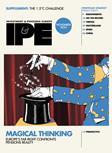Yield curve/duration
Another rate cut from the US Federal Reserve was announced in the midst of some very ugly reporting numbers from several of the leading US investment banks. In its accompanying statement after announcing the quarter point cut, the Fed made it very clear that this was to be the last “precautionary” cut and that further cuts would require factual evidence of economic weakness, as opposed to the fears and forecasts.
Although Europe’s third quarter earnings have not caused quite such bewilderment, the latest release of the euro-zone inflation data made for some rather unpleasant reading. The large jump to 2.6% for the HICP data for October was worse than even the most pessimistic forecasts, and takes headline inflation to its highest point in two years and will most certainly have put the ECB council members on high alert.
The combination of euro-zone business surveys still indicating that economic growth will moderate as the year ends, the strength of the euro acting as a further drag on the economy, and the ongoing flight-to-quality trend all suggest lower government bond yields. However now that it seems possible headline inflation will reach a higher peak than previously thought is a pretty bearish signal for bonds. Uncomfortable times for central bankers and bond investors.
Covered bonds
A very welcome return by Spanish bank Santander to the jumbo cedulas sector this month, the first issuance there for three months. There was considerable relief that the five-year issue, though not hugely over-subscribed, traded smoothly and reasonably narrowly after its launch. Although it may yet be a while before the banks return to targeting their preferred 10-year maturity, the jumbo CB market is much relieved with itself for having overcome this particular hurdle.
Although the market had been stabilising, results from Washington Mutual (WAMU) did, somewhat unsurprisingly, provoke spread widening particularly after rating agency Fitch put WAMU’s single-A rating on negative outlook. On balance, it appears that WAMU’s covered bond AAA ratings should remain unscathed.
In the UK, the authorities’ attempts to get covered bond legislation in place by the start of 2008 may be in jeopardy if the UK Treasury does rework its original draft to counter criticisms from, for example, the Investment Management Association (IMA). The IMA has said that the overall framework is too lax, a call that has perhaps gained impetus in the light of much of the developments about ratings uncertainties in the credit markets.
Investment grade credit
Bank paper continues to take the limelight, for the most uncomfortable reasons. Shockingly bad figures from Citigroup and Merrill Lynch in the US threw investor confidence a heavy punch, and increased nerves ahead of other announcements and revelations about true exposure to the US sub-prime market and other less than prime quality loans.
Although all three credit rating agencies have been putting various banks on credit watch, it seems that many investors have already assumed more unpleasant news is to come, without looking to the rating agencies to tell them. Generally, market uncertainty is on the rise, with the VIX climbing above 23%.
Within investment grade credit, bank paper continues to underperform corporate, despite what are now very wide spread premia. AA-rated HBOS, for example, is trading wider than a crossover credit (such as Ahold) in five years.
Such is the level of uncertainty as to which banks are exposed to what dubious debt, that investors will shun bank paper in favour of companies whose balance sheets appear to be much easier to read. If, as some expect, the US dips into a consumer-led recession then the fear must be that these very wide spreads on financials are justified and may yet move wider still if past experience, say like in the early 1990s, is repeated. Are the subprime problems just the first symptoms of a much more serious illness?
High yield
On the one hand, economic pessimists argue that the US is now heading for a consumer-led recession, which will bring with it a quick and painful rise in the default rate as cash-starved companies fail to secure the liquidity they need. Although risk premia have risen from the historic lows, for many investors there are still too many dark unknowns about just how bad the sub-prime fallout will be to justify an overweight position in high yield (HY).
The more optimistic arguments point to the fact yield premia are now discounting far too bearish a scenario. Balance sheets are in a reasonable state overall, and liquidity will not dry up for the majority of companies, many of whom have already locked in attractive funding rates, and thereby managing largely to immunise themselves from the current market conditions. Additionally, the optimists contend , the technical side remains supportive, viz demand for yield assets from investors worldwide and from sovereign wealth funds.
The fortunes of HY have been closely tied to that of equity markets, thus ‘enjoying’ quite similar roller coaster trading, albeit rather less stomach churning.
Emerging markets
According to IMF estimates, the combined GDPs of emerging market (EM) countries, including the Middle East, this year account for almost 30% of the global economy, compared to a 21% share in 1999. This is the sort of statistic that has helped EM markets, and most especially EM stocks stay calmer than many, enjoying meaningful bounces and thereby remaining less damaged by the turmoil overturning other regions.
This relative outperformance, however, has driven EM assets to richer relative valuations than they have been for many years and as such, leaves them rather more vulnerable to profit taking and bouts of selling as we head towards the year end. A slowing US economy is clearly a negative for growth globally and will be a concern for EMs, despite the waning importance of the US as an engine for the rest of the world. For the debt markets there is another fear: inflation is rising, as food, energy and commodity prices have all been moving markedly higher. Central Banks will be anxious to show that they deserve the respect now shown to so many EM economies, and will surely tighten monetary conditions.
Credit derivatives
The Global CDO market remains extremely troubled. The rating agencies have all been hard at work downgrading scores of CDO deals, and in particular the structured finance CDO because of their links to the sub-prime mortgage market. The 2006 and 2007 vintages absolutely dominate in these downgrade actions, reflecting beautifully the simultaneous deterioration in the lending quality of the underlying sub-prime mortgage market. Furthermore, it seems pretty clear that further writedowns will be on the way. It is the CDOs of ABS - collateralised debt obligations of asset backed securities - which are most affected. The dubious quality of the underlying ABS is clearly one aspect of the problem, but another serious issue is that investors now appear to have good reason to believe that the repackaging of these risky exposures/tranches into CDOs to create AAA-rated instruments has not worked, leading directly to the conclusion that many of the existing ratings are highly questionable.












No comments yet